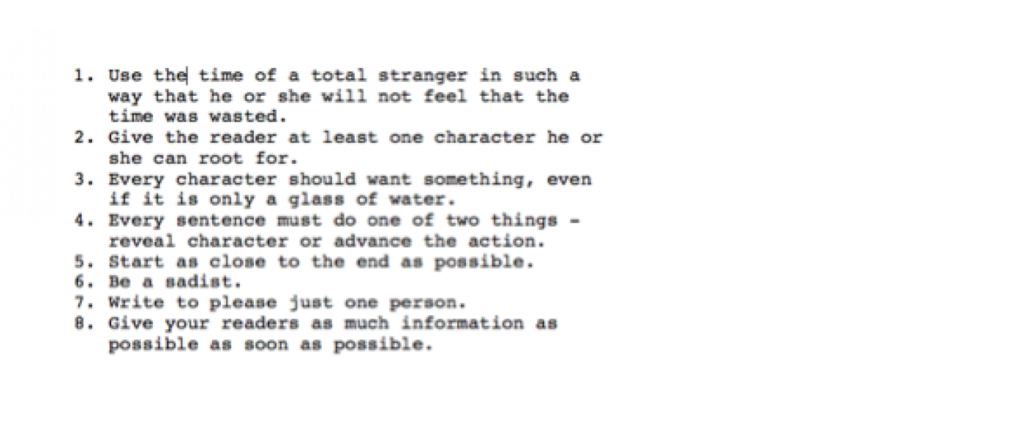Hi. Just so you know, I am writing this guide to creating content just for you. Yes, you! You work in digital marketing, or at the very least you spend some time creating online content, and you’re tired today. You have been brainstorming ideas for hours, trying to create inspirational content for a client, and currently, your day sucks.
Well, I want to tell you about my friend Billy and how Kurt Vonnegut changed his life.
All Billy wanted in life was to share amazing stories with the world but the problem was that he could never get his stories out. They stayed lodged in his throat and people never had a chance to hear them.
A group of bigger boys would be stood in a circle in the school playground. Billy would break into the middle and just as he was about to open his mouth to let a story so big, bold and hilarious escape, he would freeze, unable to utter a word.
This went on. As a teenager, he wanted to tell the story of his heart to the girls he liked. He couldn’t – not once. At college it continued to happen. His grades suffered. He found it hard to make friends.
At the age of 22, Billy witnessed the most incredible thing that anyone has probably ever witnessed. The cameras were there and the microphones too, desperate for the details from the one person who saw it all. Billy choked. Couldn’t get a single syllable out. The world watched and the world knew all too well that he couldn’t do it.
Anyway, Billy got older. And still he was incapable of telling a story. He learnt how to deal with it by talking about the process of story-telling. When it came to talking about telling stories, he was impeccable, world-beating. And this is how, against the odds, he got a job as a content marketer and he found himself in the uncomfortable position of having to tell stories for a living.
It went badly, as you might expect. He delegated. Wrote aimless articles with no narrative and even less success. Soon enough he caught his boss’s eye – and not in a good way. It was around this time when Billy, with tears still stinging in his eyes, walked into a bookshop and found a book that would change everything. It was called Bagombo Snuff Box and written by Kurt Vonnegut.
It was the introduction that did it for Billy:
Kurt Vonnegut’s Eight Tips on How to Write a Good Short Story

He read over the eight points many times. It became a mantra. Each time he completed it, he felt something deep inside him loosen. He made notes about how each point applied to his job. It changed everything.
1. Use the time of a total stranger in such a way that he or she will not feel the time was wasted.
Content has to be relevant to the reader and it has to be interesting, engaging and informative. Once the reader has finished reading it, they have to be struck with how useful it was. Content without a clearly defined purpose and genuine worth is pointless and the reader will feel cheated.
2. Give the reader at least one character he or she can root for.
A character doesn’t have to be a physical person. Your content just needs to have a primary focus – a single driving reason to exist and this must be made clear to the reader at every opportunity.
3. Every character should want something, even if it is only a glass of water.
Qualify the existence of any piece of information. If you mention a theme or a mobile app or quote make sure it has a reason to exist within your content.
4. Every sentence must do one of two things–reveal character or advance the action.
People don’t have hours to read your content. Whether it’s a piece of micro-content for a landing page or a blog post, make sure every word of every sentence has a clear purpose and is busy doing something.
5. Start as close to the end as possible.
Get to the heart of the issue as soon as possible. Many people don’t need context or an over long intro, they want answers. With intent matching, people are looking for relevant information. Give it to them!
6. Be a sadist. No matter how sweet and innocent your leading characters, make awful things happen to them–in order that the reader may see what they are made of.
Interrogate your central premise. If you are writing a guide to something, think about every question someone may have and answer it in full. If you are presenting a theory or covering a topic then look at it from every angle. Do this ruthlessly.
7. Write to please just one person. If you open a window and make love to the world, so to speak, your story will get pneumonia.
Most important! Write to your target audience. Not a loosely sketched demographic but have just one person in mind. Use the language they understand, answer the questions they have and present it in the way they want to see it. By targeting your content to one person, you will help ensure its success.
8. Give your readers as much information as possible as soon as possible. To heck with suspense. Readers should have such complete understanding of what is going on, where and why, that they could finish the story themselves, should cockroaches eat the last few pages.
Aid your readers’ understanding of your content by carefully considering how it is presented. Think about, for example, featuring a menu with jump navigation, and clearly defined and useful header tags for anyone skim reading. By structuring your content in this way, the user can get to the information they want in the quickest way possible.
As you might expect, Billy was now able to tell his stories. He started telling stories and the people listened. It was a revelation.
For help telling your story, get in contact with Loom today. Give us a call on 0117 923 2021.




